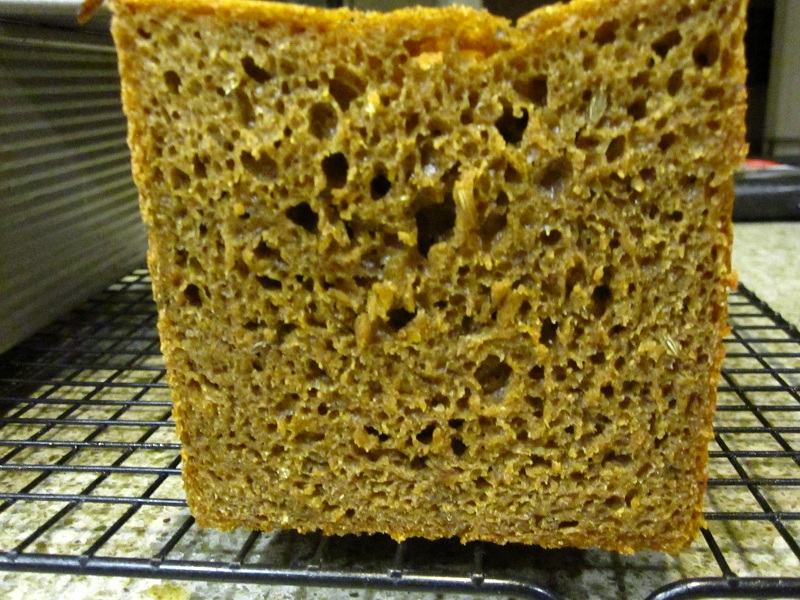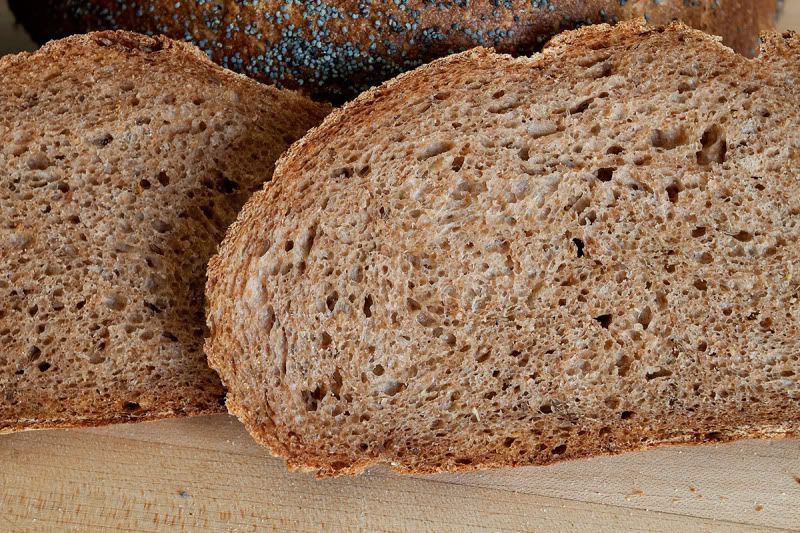A blend of Seigle d’Auvergne and Borodinski where diastatic malt is used in the dough on the French side and non diastatic malt with scalded rye berries is used on the Russian side. Thank goodness no retardation is required, no matter how nice it would be, to produce a nearly classic clash of multicultural bread with different colored malts and multi grain flours that ends up being slightly unique in the end - in a peaceful and united way. The loaf rose well during final proof but the spring was more of a sprawl. The crust is chewy the crumb is moist, soft and quite airy. It tastes like your eating really good Russian Rye bread while walking down the Champ de Elysee in the springtime. Recipe follows the pix's.

Pink Himilayan Salt, the scald, dough and levain

Red Non D and White D Malts

Rye berries being scalded with the Red ND Malt

White D Malt on white flour

Before final rise






French / Russian 57% Rye, 11% WW Rustic Bread
Starter - 10 g | | | | |
| | | | | |
rye | 1.68 | | | | |
WW | 1.66 | | | | |
AP | 1.66 | | | | |
water | 5 | | | | |
Starter | 10 | | | | |
| | | | | |
Levain- 220g | | | | | |
| Total | BP | 1st build | 2nd build | 3rd build |
Starter | 10 | 1.51% | 10 | | |
Rye | 40 | 6.02% | 10 | 20 | 10 |
WW | 40 | 6.02% | 10 | 20 | 10 |
B. Flour | 40 | 6.02% | 10 | 20 | 10 |
Water | 90 | 13.55% | 30 | 60 | |
Total | 220 | 33.13% | 70 | 120 | 30 |
| | | | | |
Scald – 53 g after scald and soak | | | |
| | | | | |
RyeBerry | 25 | 3.77% | | | |
Water | 23 | 3.46% | | | |
ND Malt | 5 | 0.75% | | | |
Scald | 53 | 7.98% | | | |
| | | | | |
Bread –391 g | | | | | |
| | | | | |
DarkRye | 67 | 10.09% | | | |
Rye | 66 | 9.94% | | | |
B. Flour | 73 | 10.99% | | | |
D. Malt | 5 | 0.75% | | | |
Salt | 5 | 0.75% | | | |
Water | 175 | 26.36% | | | |
Bread | 391 | 58.89% | | | |
| | | | | |
T. Weight | 664 | 100.00% | | | |
| | | | | |
Grains& Flour | 366 | Including scald and starter | |
Water | 293 | Including scald and starter | |
Hydration | 80.05% | | | | |
| | | | | |
Levain is | 33.13% | of the total weight. | | |
Directions
Take 10 g of 100% hydration starter and add10 Geach; Rye, WW and AP flour along with 30 g of water. Mix well, cover with plastic and let sit for 6 hours on the counter. Then add 20 g each of the same flours and 60 g water. Let sit on counter for 6 hours. Refrigerate overnight. In the morning add10 geach of the flours but no water and let sit on the counter covered in plastic wrap.
Scald the rye berries and red non-diastatic malt in50 gof water. Boil until the water barely disappears. Turn off heat and reserve covered with plastic wrap on counter with the levain. Let sit 2 hours then start autolyse.
Mix the bread flours, white distatic malt and water well, cover and autolyse for 1 hour after the scald and the levain have rested 2 hours on the counter.
Mix in the levain and let autolyse for 1 hour. Then add the scald and the salt and mix well. Do 5 S&F’s on an oiled surface and place in an oiled bowl. Then do 5 S&F’s every 20 minutes 2 more times. Pre-form into ball using the final S & F’s at the 1 hour mark and let sit in an oiled bowl for 20 minutes.
Shape as desired, I did an oval, dust with rye bran or other bran, flour or rice flour and place in prepared basket. Place basket in plastic bag and let proof until dough has risen 70% - 80%. You can also proof in a DO.
Pre heat oven to 500 F for 45 minutes, with your stone and steaming apparatus in place. No steam needed if using a DO. Take dough out of benetton by overturning onto a piece of parchment on a peel. Slide bread and parchment paper into oven onto the baking stone. Turn oven down to 450 F and bake for 15 minutes. Remove steaming apparatus and turn down oven to 425 F with convection on now. Bake about 20 minutes more until bread reaches 205 F in the middle. Let sit on stone, in off oven, with the door ajar for 10 minutes. Cool on rack.
If using DO, bake at 500 F for 20 minutes with lid on, then remove lid and turn down temperature to 450 F. Bake about 20 minutes more until middle of bread is 205 F.





















